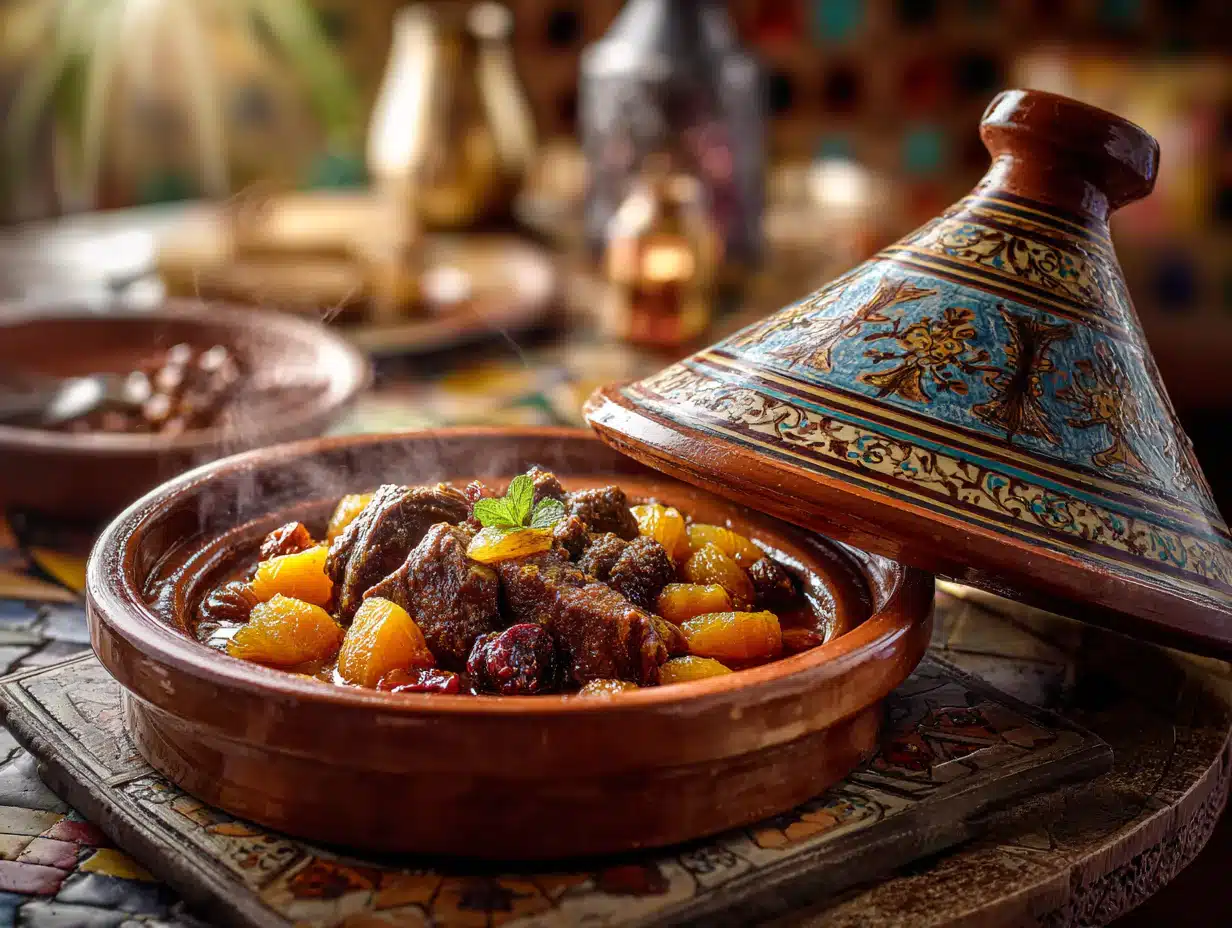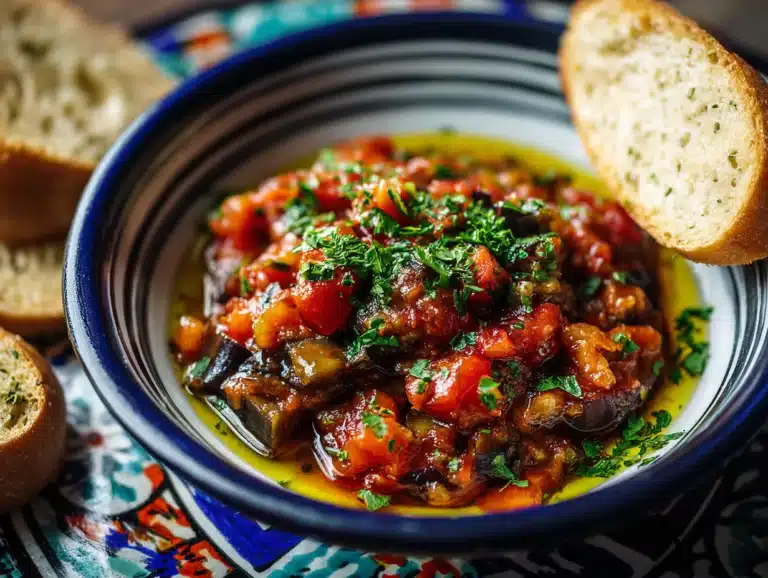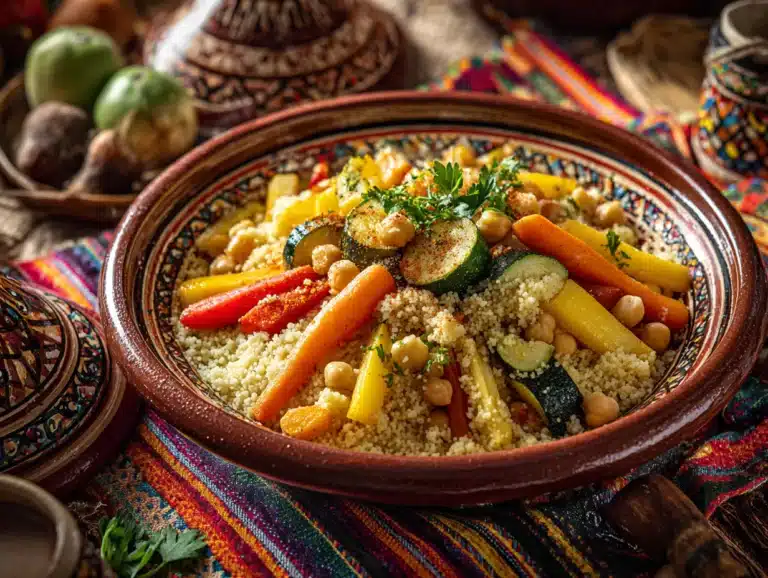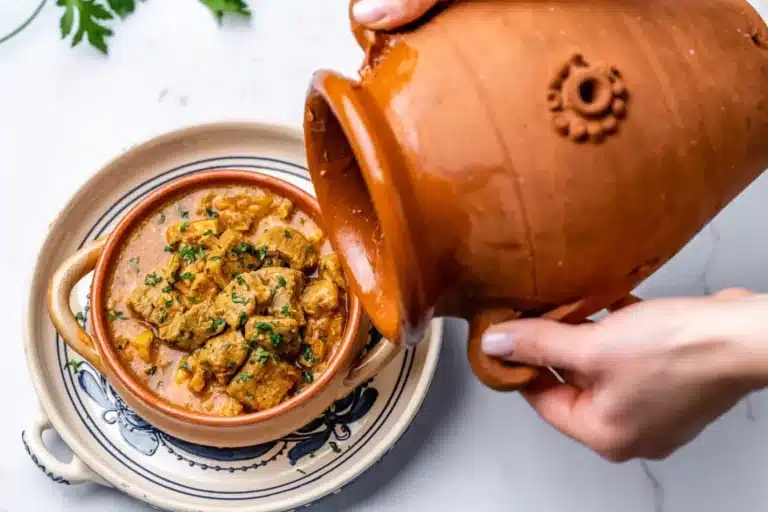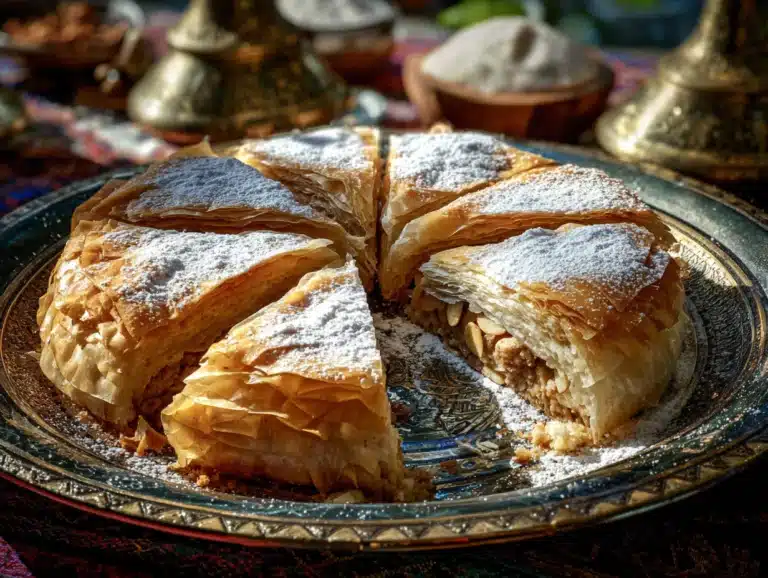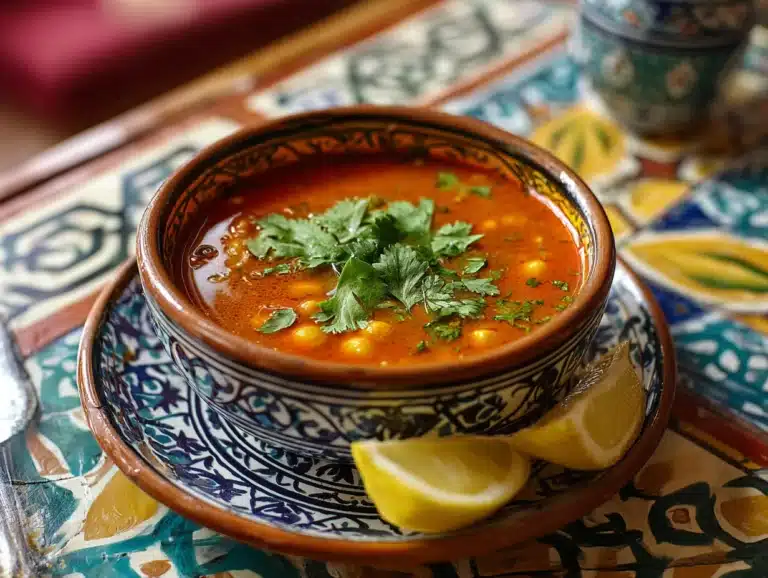Moroccan Tagine: Authentic Recipe in 5 Easy Steps to Try
Tagine is Morocco’s iconic slow-cooked stew, featuring tender chicken simmered with aromatic spices, preserved lemons, and olives in a traditional clay pot. This authentic Moroccan chicken tagine recipe delivers complex flavors and tender meat that falls off the bone, creating a memorable dining experience that captures the essence of North African cuisine.
Overview of Moroccan Cuisine
Moroccan cuisine represents centuries of culinary evolution, blending Berber, Arab, Mediterranean, and French influences into a distinctive gastronomic tradition. The heart of Moroccan food lies in its sophisticated spice combinations, slow-cooking techniques, and the harmonious balance of sweet and savory flavors.
Moroccan recipes traditionally emphasize communal dining and hospitality, with dishes designed to be shared among family and friends. The tagine cooking method exemplifies this philosophy, creating meals that bring people together around aromatic, flavorful stews.
The foundation of authentic Moroccan cuisine rests on key ingredients like preserved lemons, olives, almonds, dried fruits, and complex spice blends such as ras el hanout. These elements combine to create the distinctive taste profile that makes Moroccan food instantly recognizable worldwide.
Best Time to Cook This Dish
Moroccan tagine shines during cooler months when its warming spices and hearty ingredients provide comfort and satisfaction. The slow-cooking process makes it perfect for weekend meal preparation or special occasions when you have time to let flavors develop properly.
Religious celebrations and holidays often feature elaborate tagine preparations. During Ramadan, families frequently prepare chicken tagine for iftar meals, while Eid festivities showcase more luxurious versions with lamb or beef and dried fruits.
Seasonal ingredients enhance tagine’s appeal throughout the year. Spring versions might feature fresh artichokes and peas, while autumn tagines incorporate root vegetables and winter squash for heartier preparations.
Cultural Significance of Tagine
The tagine pot itself holds deep cultural significance in Moroccan society, representing both practical cooking wisdom and artistic expression. These conical clay vessels have been used for centuries, with their unique shape allowing steam to circulate and condense, creating incredibly tender results.
Traditional Moroccan cooking often involves communal preparation, with family members gathering to help with ingredient preparation and cooking. The tagine’s slow-cooking nature encourages patience and mindfulness, values deeply embedded in Moroccan culture.
In Moroccan households, tagine recipes pass from generation to generation, with each family adding their own touches and variations. The dish represents continuity, tradition, and the importance of preserving culinary heritage in an increasingly globalized world.
Ingredients Needed

For the Chicken:
- 1 whole chicken (3-4 lbs), cut into pieces
- 2 tablespoons olive oil
- 1 teaspoon salt
- 1/2 teaspoon black pepper
Aromatics and Vegetables:
- 2 large onions, thinly sliced
- 4 garlic cloves, minced
- 1 inch fresh ginger, grated
- 2 carrots, cut into chunks
- 1 cup green olives, pitted
- 1/4 cup preserved lemons, chopped (or 2 fresh lemons, juiced and zested)
Spice Blend:
- 1 teaspoon ground cinnamon
- 1 teaspoon ground ginger
- 1 teaspoon ground cumin
- 1 teaspoon ground coriander
- 1/2 teaspoon ground turmeric
- 1/2 teaspoon ground paprika
- 1/4 teaspoon saffron threads
- 1/4 teaspoon cayenne pepper
Additional Ingredients:
- 2 cups chicken broth
- 1/4 cup dried apricots, chopped
- 1/4 cup almonds, blanched and sliced
- 2 tablespoons honey
- Fresh cilantro and parsley for garnish
Substitution notes for international cooks: Replace preserved lemons with fresh lemon juice and zest, substitute dried apricots with dates or prunes, and use any combination of available olives if Moroccan varieties aren’t accessible.
Step-by-Step Instructions
Preparing the Chicken:
- Season the chicken: Pat chicken pieces dry and season generously with salt and pepper. Let stand at room temperature for 30 minutes to ensure even cooking.
- Brown the chicken: Heat olive oil in your tagine pot or heavy-bottomed dutch oven over medium-high heat. Brown chicken pieces on all sides, about 6-8 minutes total. Remove and set aside.
- Build the aromatics: In the same pot, add sliced onions and cook until golden and softened, about 8-10 minutes. Add minced garlic and grated ginger, cooking for another minute until fragrant.
Creating the Flavor Base:
- Toast the spices: Add all ground spices to the onion mixture, stirring constantly for 30 seconds until aromatic. This step releases essential oils and intensifies flavor.
- Deglaze and combine: Pour in chicken broth, scraping up any browned bits from the bottom of the pot. These fond particles add crucial depth to the final dish.
- Add sweetness: Stir in honey, dried apricots, and half of the preserved lemons. The sweet-savory balance is fundamental to authentic Moroccan tagine.
Slow Cooking Process:
- Return chicken: Nestle browned chicken pieces into the sauce, ensuring they’re mostly submerged. Bring to a gentle simmer.
- Cover and cook: Reduce heat to low, cover with tagine lid or tight-fitting lid, and simmer for 45 minutes. The low, slow cooking ensures tender, fall-off-the-bone chicken.
- Add vegetables: Add carrots and continue cooking for another 20-25 minutes until chicken is completely tender and vegetables are cooked through.
Final Touches:
- Finish with olives: Stir in green olives and remaining preserved lemons during the last 10 minutes of cooking. This preserves their texture and bright flavor.
- Garnish and rest: Remove from heat, sprinkle with sliced almonds and fresh herbs. Let rest for 5 minutes before serving to allow flavors to meld.
Cooking Tips & Tricks
Tagine pot preparation is crucial for authentic results. If using a clay tagine for the first time, season it by soaking in water for several hours and gradually heating to prevent cracking.
Spice quality makes a significant difference in final flavor. Use whole spices when possible, grinding them fresh for maximum potency. Store spices in airtight containers away from light and heat.
Liquid management requires attention throughout cooking. If the tagine becomes too dry, add small amounts of warm broth. If too watery, remove the lid during the last 15 minutes to allow reduction.
Traditional technique involves very gentle heat. Authentic tagine cooking uses minimal liquid, relying on the ingredients’ natural moisture and the pot’s steam circulation for tender results.
Flavor development benefits from advance preparation. The dish actually improves when made a day ahead, allowing spices to penetrate fully and flavors to marry completely.
Serving Suggestions
Traditional presentation involves serving the tagine directly from the cooking pot, placed on a decorative trivet or heat-resistant surface. Provide individual plates and Moroccan bread for authentic dining.
Moroccan bread (khubz) is essential for soaking up the flavorful sauce. If unavailable, warm pita bread or crusty artisan bread works well as substitutes.
Complementary sides include Moroccan couscous, which perfectly absorbs the tagine’s rich sauce. Rice pilaf or quinoa also pair beautifully with the complex flavors.
Beverage pairings traditionally include Moroccan mint tea, which aids digestion and provides a refreshing contrast. Light red wines or crisp white wines also complement the dish’s spice profile.
Storage & Leftovers
Proper storage involves transferring cooled tagine to airtight containers and refrigerating for up to 4 days. The flavors continue developing, often making leftovers even more delicious than the original meal.
Reheating methods work best with gentle heat. Use low stovetop heat or moderate oven temperature (325°F), adding a splash of broth if needed to prevent sticking.
Freezing capability extends storage up to 3 months. Freeze in portion-sized containers for convenient future meals. Thaw overnight in refrigerator before reheating.
Creative repurposing transforms leftover tagine into new dishes. Shred the chicken for sandwiches, use as pizza topping, or incorporate into grain bowls for quick, flavorful meals.
Common FAQs
What is the difference between tagine and tajine?
Both spellings refer to the same dish and cooking vessel. “Tagine” is the more common English spelling, while “tajine” follows French transliteration.
Can I make tagine without a tagine pot?
Yes, any heavy-bottomed pot with a tight-fitting lid works well. Dutch ovens, slow cookers, or even covered casserole dishes produce excellent results.
How do I know when the chicken is done?
The meat should be tender enough to fall off the bone easily, and internal temperature should reach 165°F (74°C) for food safety.
Can I substitute chicken with other proteins?
Absolutely. Lamb, beef, or even vegetables work wonderfully. Adjust cooking times accordingly lamb and beef require longer cooking periods.
Where can I find preserved lemons?
Middle Eastern markets, specialty food stores, or online retailers stock preserved lemons. You can also make them at home with salt, lemons, and patience.
Is tagine healthy?
Yes, tagine cooking methods preserve nutrients while using minimal added fats. The dish provides protein, vegetables, and beneficial spices with anti-inflammatory properties.
Conclusion
This authentic Moroccan chicken tagine recipe brings the warm hospitality and rich flavors of North African cuisine to your table. The combination of tender chicken, aromatic spices, and traditional cooking methods creates a memorable meal that celebrates Morocco’s culinary heritage.
The slow-cooking process may require patience, but the results incredibly tender meat infused with complex, layered flavors make every minute worthwhile. Each bite delivers the authentic taste of Morocco, from the sweetness of apricots to the briny depth of olives and preserved lemons.
Ready to experience authentic Moroccan flavors? Try this traditional tagine recipe today and discover why this ancient cooking method continues to captivate food lovers worldwide. Subscribe to our newsletter for more authentic Moroccan recipes and cooking tips that bring the magic of North African cuisine to your kitchen.
Recipe Card Summary:
- Prep Time: 30 minutes
- Cook Time: 1 hour 30 minutes
- Total Time: 2 hours
- Servings: 4-6 people
- Difficulty: Intermediate
- Cuisine: Moroccan
- Diet: Gluten-free, Dairy-free
Explore more traditional Moroccan dishes in our couscous recipes and Moroccan desserts collections.

